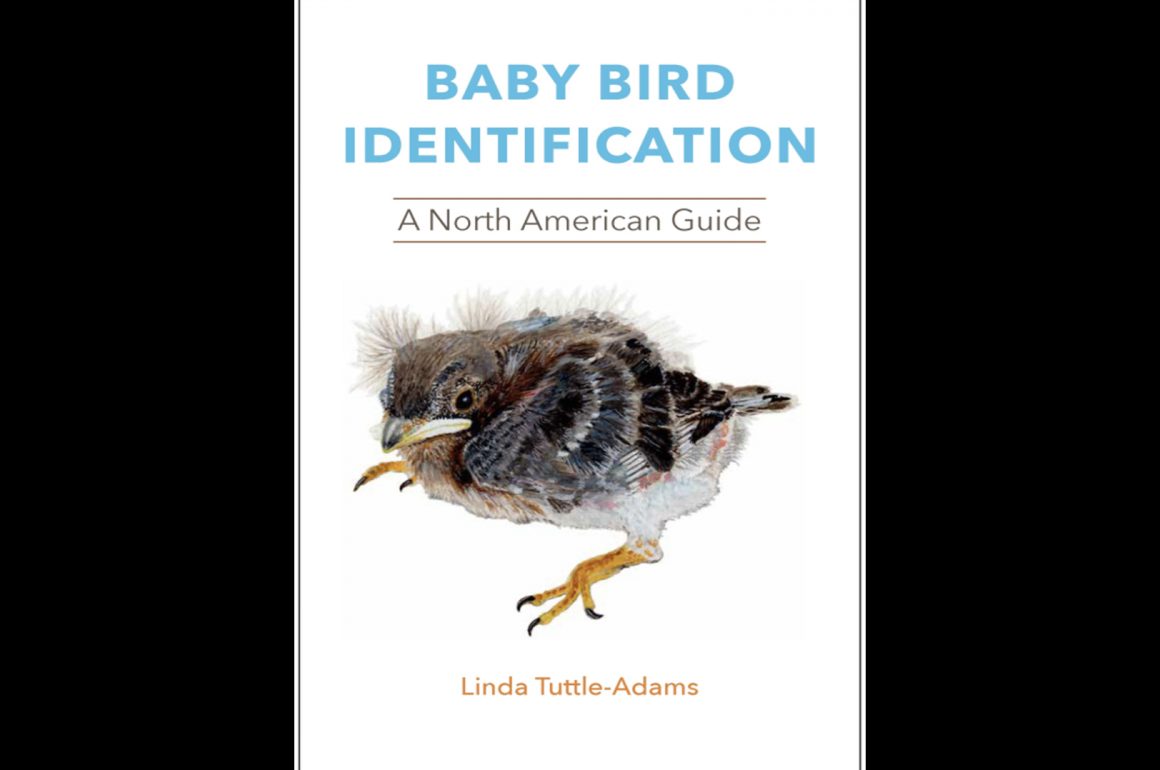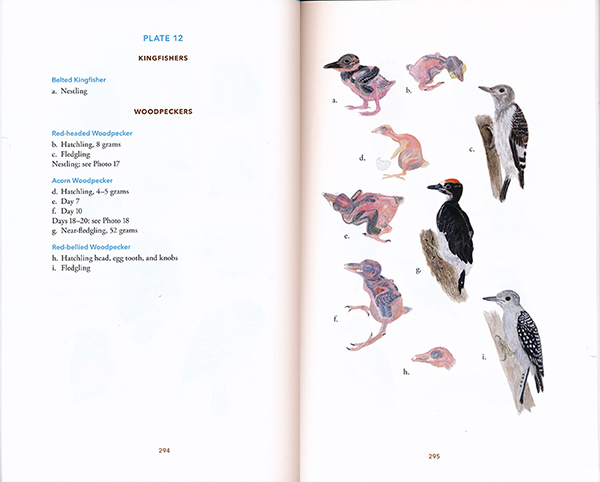
Everyone loves baby birds; 10,000 Birds even had a Baby Bird Week once upon a time! Baby birds are cuteness personified, possibly even more so than other baby animals, including human babies, and pose interesting questions of survival and development. So, I was intrigued when I saw that Comstock Publishing, an arm of Cornell University Press, was publishing Baby Bird Identification: A North American Guide by Linda Tuttle-Adams. An impressive combination of research and artwork, combined with a pragmatic organization aimed towards quick identification, and education, Baby Bird Identification extends the frontiers of bird identification guides and is an important contribution to wildlife rehabilitation literature.
There is a question that took some time to occur to me, though I’m sure most readers thought of it immediately: “Why would anyone need an identification guide to baby birds? Aren’t they usually in their nest with their parents?” A wildlife rehabber like Linda Tuttle-Adams, or our own Suzy Gilbert, would probably laugh at that question since they are apparently often brought or hear reports about baby birds found on the ground, no adult bird in sight. Baby birds may be separated from the nest and their parents because of natural occurrences (violent weather, floods) or unknowing human interference or predators. Figuring out who the parent is may be difficult because baby birds do not look like adult birds at first or even second glance, especially altricial nestlings who have still not developed. Tuttle-Adams stresses that identification is essential to helping those hatchlings, nestlings, and chicks who need help (she also stresses that the baby bird may NOT need human intervention), and that “a misidentification may be more harmful than no identification” (p.7).
This guide comes out of Tuttle-Adams years in wildlife rehabilitation and her recognition of the need for an easily available resource that synthesizes data for species nesting in North America, one that allows rehabbers and other ornithological practitioners to quickly identify birds without hours of Internet searching and fighting through academic gateways. It covers 403 species: 172 nonpasserine species and 231 passerine species in the Species Accounts, 198 species beautifully illustrated by the author in the Plates section. Birds were selected based on (1) information available; (2) information available elsewhere (thus an emphasis on altricial species and limited waterfowl coverage, since they can be found elsewhere); (3) species most commonly encountered. The scarcity of information on the young of some avian species is astounding. I never realized how little information we have on wood warbler nestlings or knew how secretive their nesting habits can be. I am puzzled as to why Gulls and Terns are almost passed over, with less than two pages of text devoted to a family description and only six species accounts (four gulls, two terns).
Species Accounts are organized by family according to the 61st Supplement (2020) of the AOS Checklist of North and Middle American Birds (the 62nd Supplement came out while the book was in production, which is to be expected). The summary of shared family characteristics is an important element of the Accounts, meant to help the user narrow down the baby bird identification to family group. The Species Accounts themselves vary in length and detail, depending on information available and necessary for identification. Almost a whole page of measurement data, plumage and bill description, and diet for adult, nestling, and fledgling Ravens; a brief paragraph on the measurements and plumage of adult, nestling, and fledgling Cliff Swallows. Family follows family with no page break, making this section a little dense. Light-blue colored headings for family and species names and capitalization of family names helps the eye focus on information. References to plate numbers (in the Plates section) and photograph numbers (in a Photo Gallery) are also placed prominently next to species name. Not all species accounts have corresponding plates or photographs.
copyright © 2022 by Cornell University, Plate 12, pages 294-295
Here is an example of one of the 36 plates, presenting Belted Kingfisher (ABA Bird of the Year!) and three of the nine woodpeckers illustrated. Woodpeckers are a family of focus for Tuttle-Adams. Woodpeckers nest in cavities and their young are altricial (born in an undeveloped state), which means there is not a lot of documented information about their young and how they look at different stages. They may look very different at various growth stages, as she shows with Acorn Woodpecker. The number of stages illustrated vary for each species, with less for precocial species (born at a mature stage) and for species, like Wood-Warblers, about which we have scarce information. As noted above, not all species in the Accounts are illustrated, and I’m disappointed at the absence of a baby Piping Plover, my favorite baby bird. Tuttle-Adams artwork is exquisitely drawn and finely colored; she succeeds in communicating the adorableness of each baby bird without sacrificing the detail necessary for accurate and useful scientific illustration.
The last subsection of the Species Accounts is the Photo Gallery, 66 small images of what appears to be photos of baby birds in rehab care taken by the author and rehab colleagues. These are mainly western species, a reflection of the author’s location. Many are hatchling birds and it’s a little startling to see their naked vulnerability. I would have like a little more explanation of where the photos came from and what stories they represent. But perhaps that’s for a different book.
The chapters preceding the Species Accounts are important for rehabilitation identification: texts on baby bird anatomy and development, the importance of bird identification to the rehab process, and a systematic identification process. The anatomy chapter goes deep into mouths and beaks–features often essential to baby bird identification. We don’t think about mouth color when we identify adult birds, but they are important clues to narrowing down taxonomic families. Beaks, on the other hand, help identify a nestling in the same way they help identify an adult–plumage may change with age, but the shape and structure of a beak often remains the same. And there is such a diversity of beak shapes! The descriptors used in the tables on beak size and shape are illustrated in the “Illustrated Glossary” in the beginning of the book. The chapter on “The Process of Identification” is a fascinating read (even to someone like me who is not a rehabilitation person). It includes questions to ask the finder, color-coded flow charts for eliminating possibilities, tables of nest types, and a step-by-step guide on what to look for while examining the hatchling or nestling. This information is not geographical specific, and the author suggests can be used world-wide by rehabilitation practitioners. (I have no background in rehabilitation other than once placing a stunned Tufted Titmouse that had found its way into my workplace into a warm box till it recovered, so I am relying on Tuttle-Adams’ expertise for these things. Comments from more experienced readers are welcome.)
There is also ample reference material in the front and back of the guide. Significantly, the Introduction begins with “A Note to Readers: Ethical Considerations Regarding Wildlife” that offers guidelines on handling birds, for photographing nests and young, and for photographing wild birds in captive settings. These prescriptions are very important to Tuttle-Adams, who takes the perhaps radical approach that a bird’s welfare supersedes a birder’s ‘right’ to take a photograph. Next is the already noted “Illustrated Glossary” is a unique collection of photographs and drawings illustrating scientific terms for parts of the mouth and beak; bones of the leg, feet, and wings; feather tracts; feather development; as well as the standard bird topography diagrams. Appendixes include a chapter on color charts and terminology, an identification worksheet, growth and development tables, and species comparison tables. It’s as if Tuttle-White has gathered and organized so much rich educational material she didn’t know where to put it all. There is also an Internet counterpart to the guide, Baby Bird Identification, that offers the basics of Tuttle-Adams’ identification process, the book’s bird family information, and basic resources.
Baby Bird Identification: A North American Guide is baby birds taken seriously, an identification guide for wildlife rehabilitators, a visual and educational treat for the rest of us. There are other books about baby birds, most notably Julie Zickefoose’s Baby Birds: An Artist Looks into the Nest (2016) and
Laura Erickson and Marie Read’s Into the Nest: Intimate Views of the Courting, Parenting, and Family Lives of Familiar Birds (2015). These books are concerned with behavior. The identification guide by Paul J. Baicich and Colin J. O. Harrison, and Nests, Eggs, and Nestlings of North American Birds, 2nd ed. (2005) covers some of the territory of Baby Bird Identification and more, it’s one of the reasons Tuttle-Adams has so few drawings of waterfowl, waterbirds, and shorebirds–you can find them here. A birder or rehabber looking for a comprehensive collection should consider having both books in their collection.
Baby Bird Identification focuses on scientific data, synthesizing information gathered from reference books, journal articles and databases, unpublished data, and data collected by the author herself. It is not an identification guide for everybody. Which just might be the future of identification and field guides–books filling specialized niches, offering essential information to practitioners and naturalists interested in specific families, habitats, and avian developmental stages. It emphasizes the importance of the work of wildlife rehabilitators (thank you!) and of the essential role baby birds have in our lives, because without them, of course, we would not have adult birds, and we can’t take that for granted.
And one more thing, readers of 10,000 Birds–A Happy, Health, Birdy New Year!
Baby Bird Identification: A North American Guide
by Linda Tuttle-Adams; foreword By Rebecca S. Duerr
Comstock Publishing Associates/Cornell University Press, October 2022
Paperback, 432 pages
Illustrations: 68 color photo, 1 b&w halftone, 379 illustrations, 2 charts
Dimensions: 6 x 9 x 0 in
ISBN: 13: 9781501762857; ISBN: 10: 1501762850
$39.95












Leave a Comment